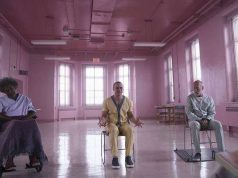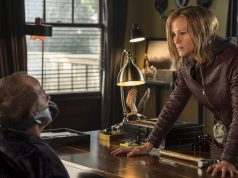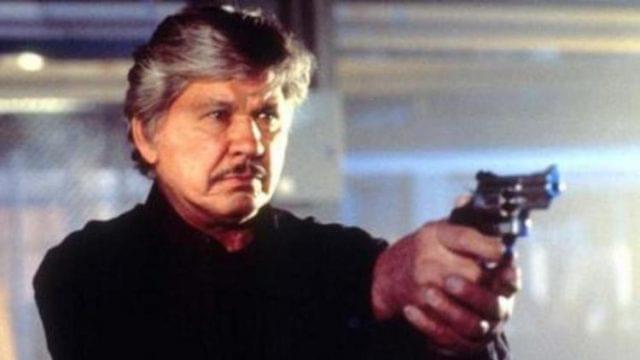
In 1974, movie audiences were enchanted by “Death Wish,” a delightful romp in which a man named Paul Kersey (Charles Bronson) goes on a killing spree after his wife is murdered and his daughter raped. His killing spree only targeted criminals, though, so he wasn’t a dangerous psychopath but simply a concerned citizen. That’s how audiences were able to root for him. If you think about it, killing criminals is really no different from voting.
The film was popular enough for Bronson to star in a sequel eight years later, in which Paul’s daughter is raped again. She’s killed, too, thus sparing her from having to get raped a third time in the next sequel. (“They wouldn’t have done that!” you say. Well, you wouldn’t have thought they’d do it a second time, either.) “Death Wish III,” having run of out of family members to brutalize, had to attack Paul’s friends instead. “Death Wish 4: The Crackdown” put him up against Los Angeles drug dealers after his girlfriend’s daughter died of an overdose. At this point, he was really just killing anyone who looked at him funny.
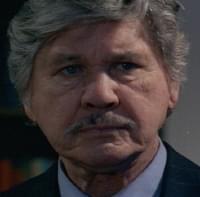
That brings us to the last film in the “Death Wish” series, commonly known as “Death Wish V” but bearing the onscreen title “Death Wish: The Face of Death.” I assume that refers to Bronson’s own face, which is perfectly round, haggard, and weather-beaten, and which was 73 years old when the film was released. Seventy-three is awfully old to still be killing people. Most men have lost their bloodlust by the time they reach retirement age, having replaced it with tapiocalust and Matlocklust.
The victim this time is Paul’s girlfriend, a fashion designer named Olivia (Lesley-Anne Down) who evidently didn’t get the memo that if you have any kind of relationship with Paul Kersey, you will be murdered. She probably thought she’d be safe hooking up with a man 30 years her senior. Her ex-husband, Tommy O’Shea (Michael Parks), is a gangster with his mitts on every aspect of Olivia’s fashion empire. Paul is at Olivia’s headquarters for a fashion show — the one thing Paul loves more than shooting muggers is seeing a new line of haute couture unveiled! — when Tommy shows up, too, to harass the hired help.
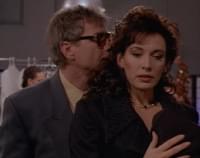
Olivia’s fashion empire is all located in one building, it turns out: The fashion show is upstairs, while downstairs is the actual factory where the clothes are made. Is this how real designers do it? Does Marc Jacobs hold his runway shows one floor up from his sweatshop? Wouldn’t it be risky to have well-paid, temperamental models using the same hallways and elevators as the minimum-wage seamstresses and machinists?
Olivia’s factory also has a huge, open vat of acid, with no guardrails to keep people from falling into it. If you’re wondering why a clothing factory needs a huge, open vat of acid, much less one with nothing to prevent deadly workplace accidents, it’s so that Tommy can toss a mannequin in for the purpose of making a point, and also so that Tommy himself can fall in at the end of the movie. It will be “ironic,” you see, that the very thing he used to taunt others will be the thing that kills him. Better put on your irony pants and get ready!
Anyway, once Paul learns that his girlfriend’s ex-husband is a violent creep, he thinks: Here’s a guy I have something in common with! No, I’m kidding. He doesn’t think that. He thinks: I’m gonna put a stop to this. He calls up an old cop friend named Hoyle (Saul Rubinek) and tells him and his partner, Vasquez (Miguel Sandoval), that Olivia will gladly testify in court against Tommy. The cops are thrilled, as they’ve been trying to build a case against Tommy for 16 years, and evidently never thought that his embittered ex-wife might be a good witness.
Almost immediately, Tommy learns that Olivia is going to rat on him and sends one of his goons, Freddie (Robert Joy), to rough her up. Freddie, who is paranoid and suffers from chronic dandruff — two details that are irrelevant but that the film keeps mentioning — catches Olivia in the bathroom at a fancy restaurant and smashes her face against the mirror several times. Olivia survives the attack but hates how grotesque she looks with all her scars. She goes on and on about it, all sad-like. She’s a monster now! Gaze, if you dare, at her hideous visage!

I know, right??! Just think of the poor actress, having to sit in the makeup chair for a good five minutes while someone scribbled some lines on her.
Oh, and then Freddie shows up at Olivia’s house and kills her all the way dead, not just face-in-the-mirror dead. He and his assistants also fire about a hundred shots at Paul but never hit him, not once, ever, in the entire movie, no matter how close they are or how many bullets they fire. Paul isn’t just elderly; he’s bulletproof.
Meanwhile, the cops are trying to get some other witnesses, too, which is a pretty good idea under the circumstances. They get a fat guy named Albert (Jefferson Mappin), who works in the factory, to wear a wire while speaking with Tommy’s goons; Tommy’s goons immediately detect this; Freddie runs Albert down with his car, sending him crashing through a restaurant window. (Who ordered the fat guy?) (Hey, I wanted this fat guy TO GO!)
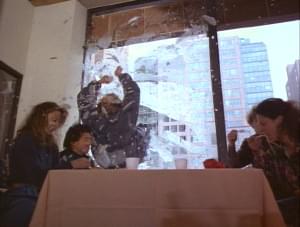
It’s obvious now that someone in the police department is tipping Tommy off about the investigation. Paul wonders if Hoyle’s phone is bugged, but no — the turncoat, a fellow cop, is listening in by simply picking up the phone in the other room, the same way little boys eavesdrop on their teenage sisters. “Death Wish: The Face of Death” is a state-of-the-art techno-thriller!
This is when Paul finally gets off his lazy septuagenarian butt and starts murdering people. First he goes for one of Tommy’s hired goons, an Italian-American whom Paul kills by putting cyanide in his cannoli (if you know what I mean). Then he kills Freddie with a remote-controlled soccer ball that he buys at a toy store. He rolls the ball into Freddie’s gated front yard, then detonates it when Freddie picks it up. Oh, yeah, I forgot to mention, it’s also a bomb. This is not explained. Is that how it’s sold at the toy store? Did Paul alter it himself? Since when does Paul know how to make explosives? What’s the point of a remote-controlled soccer ball anyway? Is there a company that makes remote-controlled soccer balls that was hoping this would be its Reese’s-Pieces-in-“E.T.” moment?
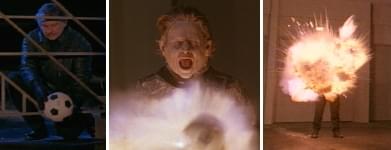
I should probably mention that Olivia had a daughter, Chelsea, who is really sad about her mom’s death and doesn’t like her dad, and will probably like him even less when she finds out that he’s the one who had her mom killed. (You expect your divorced parents to fight, sure, but not murder each other. That just isn’t done.) Tommy, as her only relative, gets custody of her when Olivia dies, his involvement in Olivia’s death being irrelevant because it can’t be proven. Well, it probably COULD be proven. Paul saw the men who did the killing, and they can easily be identified as regular associates of Tommy’s. What I meant was that Tommy’s complicity in Olivia’s murder can’t be proven without doing some basic, uncomplicated police work, and that’s where the cops in this film draw the line. Remember, they’ve been trying for 16 years to establish a case against a man who brazenly kills people in broad daylight and throws mannequins into acid vats for purposes of ironic comeuppance.
In previous “Death Wish” movies, Paul would often kill people who were criminals but who didn’t necessarily have anything to do with whatever specific crimes he was avenging. “Death Wish: The Face of Death” is much more focused, though, and the only people at the receiving end of Paul’s metaphorical vigilante hammer are ones who were directly connected to the matter at hand. I imagine Paul, now well into his twilight years, sitting in a quiet room, reflecting on his life, and thinking, “You know, I’m glad to have spent the last 20 years gleefully dispatching any miscreant who happened to cross my path. I cannot imagine a more fruitful and rewarding way to live. Yet as my sojourn on this earth draws to a close, I wonder if killing only specific criminals would grant me more time to relax and enjoy life’s simpler pleasures, lest perchance I go to meet my Maker without ever having done a single good deed that didn’t end with bloodstains on my shirt.” Newly contemplative and Zen-like, Paul now murders only those who have done wrong to him directly. When that’s all taken care of he can be a surrogate father to young Chelsea — and it’s lucky for her they never got around to making “Death Wish 6.”
— Film.com



